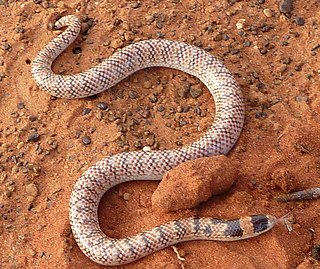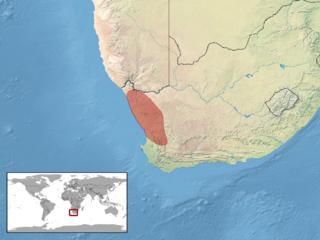
The tiger snake is a large and highly venomous snake of southern Australia, including its coastal islands and Tasmania. These snakes are often observed and locally well known by their banding, black and yellow like a tiger, although the species can be highly variable in coloration and patterning. All populations are classified within the genus Notechis (Elapidae). Their diverse characteristics have been classified either as distinct species or by subspecies and regional variation.

The mud adder, also known commonly as De Vis' banded snake or Devis's banded snake, is a species of venomous snake in the family Elapidae. The species is endemic to certain regions of eastern Australia, including South West Queensland, northern New South Wales, north-west Victoria, and South Australia. Its scientific and common names refer to Charles Walter De Vis.

The rough frog, also known as the woodland water-holding frog, warty water-holding frog, and red-backed cyclorana, is a species of treefrog native to northern New South Wales and south-eastern Queensland, Australia.

Simoselaps, or Australian coral snakes, is a genus composed of 12 species of venomous elapid snakes.

Brachyurophis is a genus of elapid snakes known as shovel-nosed snakes, so named because of their shovel-nosed snout which is used to burrow. The genus has eight recognized species, which are all found in Australia.

Dendrelaphis calligaster, also called green tree snake and northern tree snake, is a colubrid snake native to Indonesia, Papua New Guinea and Australia. It is a slender, large-eyed, non-venomous, diurnal snake, which grows up to 1.2 m in length and is greenish, brown, or greyish above with a cream or yellow belly.

Pachydactylus labialis, commonly known as the Calvinia thick-toed gecko, Western Cape gecko, or Western Cape thick-toed gecko, is a gecko species endemic to the Western and Northern Cape in South Africa, often found taking shelter under stones.
Namazonurus campbelli, commonly known as Campbell's girdled lizard, is a species of lizard in the family Cordylidae. A small girdled lizard, N. campbelli is endemic to Namibia. It is often mistaken for the more common Herero girdled lizard, N. pustulatus, as they both are similar in size and have flattened bodies. N. campbelli lives in rock crevices and cracks on dry mountain slopes

The ringed brown snake is a species of venomous elapid snake native to a broad swathe of inland Australia, from western New South Wales and Queensland to Western Australia.
The collared whipsnake is a medium-sized elapid endemic to Australia. It is found in rainforest edges and other tropical woodland areas as well as in rocky habitat and environments on offshore islands.

Brachyurophis fasciolatus is a species of snake from the family Elapidae, commonly named the narrow-banded shovel-nosed snake, or narrow-banded burrowing snake, and is a species endemic to Australia. Its common names reflect its shovel nose specialization, burrowing behaviour and banded body colour.

The southern shovel-nosed snake is a species of snake native to southern Australia.
Brachyurophis incinctus is a species of snake from the family Elapidae, commonly named the unbanded shovel-nosed snake, and is a species endemic to Australia. Its common name reflects its shovel nose specialisation, burrowing behaviour and the fact that it is not banded on its body.

Brachyurophis australis(coral snake) is a species of snake from the family Elapidae (common names - eastern shovel-nosed snake, coral snake, Australian coral snake) and is a species endemic to Australia. Its common name reflects its shovel nose specialisation.
The pale-headed snake is a species of venomous snake in the family Elapidae. The species is endemic to Australia.
Brachyurophis approximans, also known as the north-western shovel-nosed snake, is a species of mildly venomous burrowing snake that is endemic to Australia. The specific epithet approximans (“approaching”) alludes to its similarity to Brachyurophis campbelli.
Brachyurophis roperi, also known as the northern shovel-nosed snake, is a species of mildly venomous burrowing snake that is endemic to Australia. The specific epithet roperi refers to the type locality of the Roper River Mission in the Northern Territory. It was formerly considered a subspecies of Brachyurophis semifasciatus.
Brachyurophis morrisi, also known as the Arnhem shovel-nosed snake, is a species of mildly venomous burrowing snake that is endemic to Australia. The specific epithet morrisi honours author and naturalist Ian James Morris for his contributions to knowledge of the animals of the Northern Territory, who first collected the species in 1970.
Cryptophis boschmai, also known commonly as the Carpentaria snake or the Carpentaria whip snake, is a species of venomous snake in the family Elapidae. The species is native to Australia and New Guinea.
Cryptophis nigrostriatus, also known as the black-striped snake, is a species of venomous snake native to Australia and New Guinea. The specific epithet nigrostriatus (“black-striped”) refers to its body markings.









